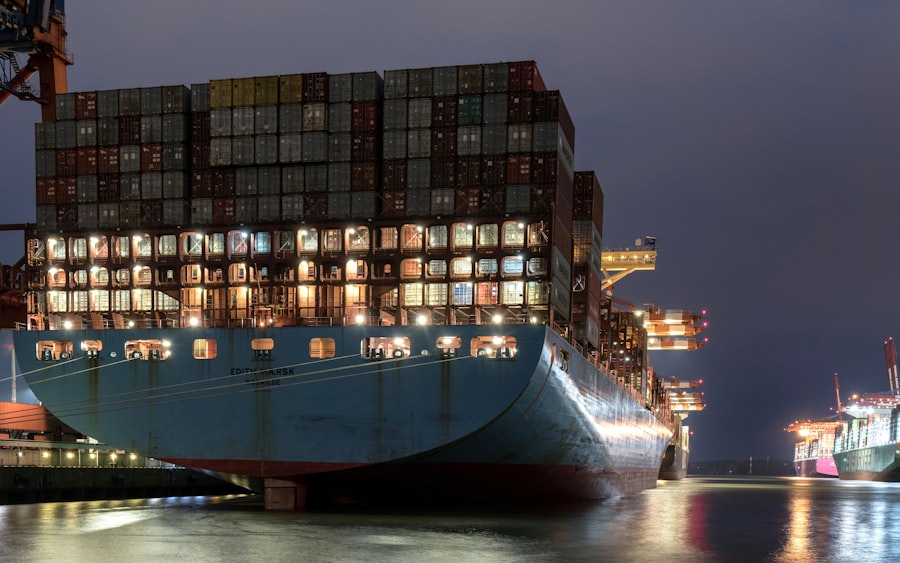The global shipping crisis has emerged as a significant challenge for economies worldwide, affecting the flow of goods and services across borders. This crisis, which began to intensify in 2020, has roots in a complex interplay of factors, including the COVID-19 pandemic, labor shortages, and increased consumer demand. As countries implemented lockdowns and restrictions, the shipping industry faced unprecedented disruptions.
Ports became congested, and container availability dwindled, leading to delays and increased costs. The ramifications of this crisis extend beyond mere logistics; they touch on economic stability, inflation rates, and consumer behavior. As the world gradually recovers from the pandemic, the shipping crisis continues to evolve.
Businesses are grappling with the consequences of prolonged delays and rising freight costs. The interconnectedness of global supply chains means that disruptions in one region can have cascading effects elsewhere. For instance, a delay in shipping from Asia can lead to stock shortages in North America or Europe, impacting retailers and manufacturers alike.
Understanding the nuances of this crisis is crucial for stakeholders aiming to navigate the turbulent waters of global trade.
Key Takeaways
- The global shipping crisis is causing significant disruptions in supply chains worldwide, leading to port congestion and container shortages.
- Businesses are experiencing delays in receiving goods, increased transportation costs, and challenges in managing customer expectations.
- Factors contributing to the global shipping crisis include labor shortages, equipment imbalances, and increased consumer demand.
- Strategies for managing supply chain disruptions include diversifying transportation options, negotiating freight rates, and leveraging technology for visibility and communication.
- Long-term resilience in the supply chain requires proactive planning, collaboration with freight forwarders and carriers, and exploring alternative transportation options.
Impact of the Global Shipping Crisis on Businesses
The impact of the global shipping crisis on businesses has been profound and multifaceted. Companies across various sectors have reported significant disruptions in their supply chains, leading to inventory shortages and increased operational costs.
The inability to secure timely shipments has forced many businesses to rethink their inventory management strategies, often resulting in lost sales and diminished customer satisfaction. Moreover, the financial implications of the shipping crisis cannot be overlooked. Increased freight rates have strained profit margins for many companies, particularly small and medium-sized enterprises that lack the negotiating power of larger corporations.
As shipping costs soar, businesses are faced with difficult decisions regarding pricing strategies and cost absorption. The ripple effects of these challenges extend to consumers, who may experience higher prices for goods as businesses pass on increased costs. In this environment, adaptability and strategic planning have become essential for survival.
Factors Contributing to the Global Shipping Crisis

Several factors have converged to create the current global shipping crisis, each contributing to the overall complexity of the situation. One of the primary drivers has been the COVID-19 pandemic, which disrupted manufacturing processes and led to labor shortages in key industries. As factories closed or operated at reduced capacity, the production of goods slowed significantly.
This disruption was compounded by a surge in consumer demand as economies reopened, creating a mismatch between supply and demand that the shipping industry struggled to address. Additionally, port congestion has played a critical role in exacerbating the crisis. Major ports around the world have faced unprecedented backlogs due to a combination of factors, including labor shortages, increased shipping volumes, and inefficient logistics processes.
The result has been a bottleneck effect that delays shipments and increases transit times. Furthermore, geopolitical tensions and trade disputes have added another layer of complexity, leading to uncertainty in shipping routes and practices. Together, these factors have created a perfect storm that continues to challenge global trade.
Strategies for Managing Supply Chain Disruptions
| Strategy | Description |
|---|---|
| Inventory Optimization | Implementing inventory management techniques to reduce excess inventory and stockouts. |
| Supplier Diversification | Identifying and working with multiple suppliers to reduce dependency on a single source. |
| Risk Assessment and Mitigation | Conducting risk assessments and developing plans to mitigate potential disruptions. |
| Technology Integration | Utilizing technology such as AI, IoT, and blockchain to improve visibility and agility in the supply chain. |
| Collaborative Relationships | Building strong relationships with suppliers, customers, and partners to enhance communication and collaboration. |
In light of the ongoing global shipping crisis, businesses must adopt proactive strategies to manage supply chain disruptions effectively. One key approach is diversifying suppliers and sourcing options. By establishing relationships with multiple suppliers across different regions, companies can mitigate risks associated with relying on a single source.
This strategy not only enhances resilience but also provides flexibility in responding to unforeseen challenges. Another critical strategy involves investing in inventory management systems that allow for real-time tracking and forecasting. By leveraging technology to gain insights into inventory levels and demand patterns, businesses can make informed decisions about stock levels and reorder points.
This proactive approach can help prevent stockouts and ensure that products are available when customers need them most. Additionally, fostering strong relationships with logistics partners can facilitate smoother operations and improve communication throughout the supply chain.
Navigating Port Congestion and Container Shortages
Navigating port congestion and container shortages has become a pressing concern for businesses operating in today’s shipping landscape. As ports grapple with overwhelming volumes of cargo, delays have become commonplace, leading to frustration among shippers and consumers alike. To address these challenges, companies must adopt a multifaceted approach that includes strategic planning and collaboration with port authorities.
One effective strategy is to explore alternative ports or shipping routes that may offer more reliable service during peak congestion periods. By diversifying shipping options, businesses can reduce their reliance on heavily congested ports and potentially avoid delays altogether. Additionally, maintaining open lines of communication with logistics partners can provide valuable insights into port conditions and help businesses make informed decisions about their shipping strategies.
The Role of Technology in Mitigating Shipping Challenges

Technology plays a pivotal role in mitigating the challenges posed by the global shipping crisis. Advanced tracking systems and data analytics tools enable businesses to monitor shipments in real time, providing visibility into potential delays or disruptions. By leveraging these technologies, companies can proactively address issues before they escalate into significant problems.
Moreover, automation is transforming various aspects of the shipping process, from warehouse management to customs clearance. Automated systems streamline operations, reduce human error, and enhance overall efficiency. As businesses increasingly adopt digital solutions, they position themselves to respond more effectively to the dynamic nature of global trade.
Embracing technology not only improves operational efficiency but also fosters resilience in an ever-changing shipping landscape.
Collaborating with Freight Forwarders and Carriers
Collaboration with freight forwarders and carriers is essential for businesses seeking to navigate the complexities of the global shipping crisis effectively. These logistics partners possess valuable expertise and insights into shipping routes, regulations, and market conditions. By working closely with freight forwarders, companies can gain access to a broader network of carriers and optimize their shipping strategies.
Establishing strong relationships with logistics partners also facilitates better communication during times of disruption. When challenges arise—such as port congestion or container shortages—having a reliable partner can make all the difference in finding alternative solutions quickly. Additionally, freight forwarders can assist businesses in negotiating favorable terms with carriers, ensuring that they secure competitive rates while maintaining service quality.
Exploring Alternative Transportation Options
In response to the ongoing challenges within the global shipping landscape, businesses are increasingly exploring alternative transportation options beyond traditional maritime shipping. Air freight has gained popularity as a faster solution for urgent shipments, despite its higher costs. While air transport may not be feasible for all goods due to cost constraints, it offers a viable option for time-sensitive products that require swift delivery.
Additionally, companies are considering intermodal transportation solutions that combine different modes of transport—such as rail and truck—to optimize efficiency and reduce transit times. By leveraging multiple transportation methods, businesses can create more flexible supply chains that adapt to changing circumstances. Exploring these alternatives not only enhances resilience but also allows companies to respond more effectively to fluctuations in demand.
Negotiating Freight Rates and Contracts
Negotiating freight rates and contracts has become a critical skill for businesses navigating the complexities of the global shipping crisis. With rising freight costs impacting profit margins, companies must approach negotiations strategically to secure favorable terms with carriers. Understanding market trends and fluctuations in demand can provide leverage during negotiations.
Moreover, fostering long-term relationships with carriers can lead to more favorable contract terms over time. By demonstrating reliability as a shipper and maintaining open communication with carriers, businesses can build trust that may result in better rates or priority service during peak periods. As companies navigate this challenging landscape, effective negotiation skills will be essential for maintaining competitiveness.
Managing Customer Expectations and Communication
In an era marked by supply chain disruptions, managing customer expectations has become paramount for businesses striving to maintain customer loyalty. Clear communication is essential in setting realistic timelines for product availability and delivery. Companies must proactively inform customers about potential delays or changes in service due to ongoing shipping challenges.
Providing regular updates on order status and expected delivery times can help alleviate frustration and build trust between businesses and their customers. By prioritizing effective communication strategies, companies can enhance customer satisfaction even amid challenging circumstances.
Planning for Long-Term Resilience in the Supply Chain
As businesses continue to grapple with the ongoing global shipping crisis, planning for long-term resilience in the supply chain has become a strategic imperative. This involves not only addressing immediate challenges but also anticipating future disruptions that may arise from evolving market conditions or unforeseen events. Investing in robust risk management strategies is essential for building resilience over time.
This includes conducting regular assessments of supply chain vulnerabilities and developing contingency plans that outline steps to take during disruptions. Additionally, fostering a culture of adaptability within organizations encourages teams to embrace change and innovate solutions as challenges arise. In conclusion, while the global shipping crisis presents significant challenges for businesses worldwide, it also offers opportunities for growth and innovation.
By understanding the complexities of this crisis and implementing proactive strategies, companies can navigate disruptions effectively while positioning themselves for long-term success in an ever-evolving global marketplace.
The global shipping crisis has had far-reaching impacts on various sectors, from consumer goods to raw materials. As the world grapples with these challenges, it’s crucial to understand the underlying factors contributing to the disruptions. An insightful article that delves into the intricacies of the global shipping crisis can be found on MyGeoQuest. This piece explores the logistical hurdles and economic implications of the crisis, providing a comprehensive overview of the current situation. For more detailed information, you can read the article by visiting this link.
WATCH NOW! Unlocking Disaster: 7 Choke Points That Could Fracture Our Connected World Overnight
FAQs
What is the global shipping crisis?
The global shipping crisis refers to the current situation in which the global shipping industry is facing significant challenges and disruptions, leading to delays in the transportation of goods and increased shipping costs.
What are the causes of the global shipping crisis?
The global shipping crisis has been caused by a combination of factors, including the COVID-19 pandemic, a surge in consumer demand for goods, port congestion, container shortages, and disruptions to global supply chains.
How is the global shipping crisis impacting businesses and consumers?
The global shipping crisis is impacting businesses and consumers by causing delays in the delivery of goods, increased shipping costs, and supply chain disruptions. This has led to higher prices for consumer goods and challenges for businesses in meeting customer demand.
What are the potential solutions to the global shipping crisis?
Potential solutions to the global shipping crisis include increasing container capacity, improving port infrastructure, addressing labor shortages, and enhancing coordination among shipping companies, ports, and governments. Additionally, investing in digital technologies and alternative transportation methods may help alleviate some of the challenges.
